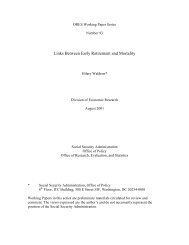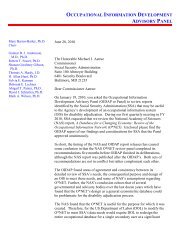The 1983 Amendments to the <strong>Social</strong> <strong>Security</strong> Actincluded, among other measures, the change in theFRA starting with the cohort attaining age 62 in 2000(those born in 1938), for whom the FRA was set at 65and 2 months. The FRA has increased by 2 monthsfor every cohort since then until it reached 66 forthose who attained age 62 in 2005, and it will stay atthat level for a decade. The FRA will increase againby 2 months for the cohort born in 1955 (who reachage 62 in 2017, and it will continue to increase by2-month increments for successive birth cohorts untilit reaches 67 for the 1960 cohort.The changes in the FRA and the DRC were clearlyeasy to anticipate by those nearing retirement age, andit is natural to expect comparatively less pronouncedchanges in behavior resulting from their phasedimplementation. 9 More unexpected was the repealof the earnings test for individuals above the FRA,which withholds benefits for individuals earning abovethe exempt amounts. The legislation was passed inthe spring of 2000, approximately a year after it wasmade a policy objective by President Clinton in early1999, and it affected earnings obtained after January1, 2000. The literature analyzing the effects ofthe earnings test is also quite large and has focusedprimarily on understanding whether people respond tothe exempt amount. 10 Given the data analyzed, we arein a position to infer possible changes in behavior thatare due to the repeal of the earnings test, which wouldotherwise be hard to characterize using householdleveldata.DataWe use the 2004 publicly available release of the Old-Age, Survivors, and Disability Insurance (OASDI)public-use microdata files to analyze the trends inclaiming behavior and level of benefits received in the1994–2004 period. 11 The 2004 Benefits and Earningspublic-use file is a 1 percent random sample of OASDIbeneficiaries who were on the <strong>Social</strong> <strong>Security</strong> recordsin December 2004. It contains 473,366 records as ofDecember 2004 and includes information in 16 fieldson OASDI beneficiaries’ characteristics, mainly aboutbenefit entitlements. This more detailed informationallows us to focus only on retired workers whoclaimed benefits on their own earnings history, andbecause it is individual-level data, we can computestandard deviations and therefore statistically comparebenefit levels across ages and years.This microdata has, however, two weaknesses.First, we have not been able to separate disabilityconversions from new entitlements for those personsclaiming benefits at age 65 or the FRA, if higher―adistinction that the public-use file does not allow us tomake. 12 What we have done to overcome this problemis to assume a proportion of <strong>Social</strong> <strong>Security</strong> claimantsfrom age-65 samples each year as disability conversions.The proportions used are calculated accordingto the Annual Statistical Supplement to the <strong>Social</strong><strong>Security</strong> Bulletin―referred to elsewhere in this articleas the Supplement (SSA 1995–2008). Second, we arerestricting attention to individuals in the MBR as ofDecember of 2004. The latter method most likelyresults in a selection bias when looking at historicaldata on individuals who claimed benefits in the decadebefore 2004. The reason is that some individuals whoclaimed in the 1990s, or even more recently, might notbe in the sample if they have died in the time sincetheir application for benefits. 13Claiming Behavior and RetirementBenefitsUsing public-use data extracts from the MBR, wenotice the well-known retirement peaks at ages 62 and65, both thinking in terms of proportions of claimersin a given calendar year and as proportions by cohortover different years. 14 It is interesting to highlight,however, that the relative sizes of these peaks, asproportions by calendar year, have changed considerablyfrom previous decades―where the largest peakoccurred at age 65 in the 1970s―or were roughly ofsimilar size during part of the 1980s. In our studyperiod, from 1994 through 2004, we see that the proportionof individuals claiming benefits at age 62 hasremained quite stable in most years (in the 48–52 percentrange) with the proportion of individuals claimingbenefits before the FRA at almost 64 percent by 2004.This is a key development of the past two decades andone that has puzzled economists considerably. 15 Onthe other hand, the proportion of individuals claimingbenefits at age 65 has remained at about 20 percent.Until recently a number of researchers have tried toexplain this with arguments regarding individual preferences(Coile, Gruber, and Jousten 2002; Gustmanand Steinmeier 2002), suggesting that there is a proportionof individuals who seem to be rather myopicand do not quite behave as forward-looking optimizers.Other authors have recently shown that once the80 <strong>Social</strong> <strong>Security</strong> Bulletin • Vol. 69 • No. 3 • 2009
full incentive structure of the system is properly modeled(mainly regarding the earnings test provisions),these proportions are much more consistent with thepredictions of a fully dynamic intertemporal model ofbehavior than previously thought (Benítez-Silva andHeiland 2007). 16Evidence on Claiming BehaviorTable 1 shows the proportion of individuals claiming<strong>Social</strong> <strong>Security</strong> retirement benefits by age in the1994–2004 period, as well as the total number ofindividuals who claimed in a given year. The totalnumber of claimants used to compute the proportionsdoes not include the disability conversions at age 65(or the FRA if higher), but does include the relativelysmall number of individuals who claim at age 70 orolder (proportions not included in the table). 17Chart 1, which illustrates the data in Table 1,shows that the proportions of individuals claimingbenefits at different ages changed dramatically in2000, with a large drop in the proportion claiming atage 62 (from 50 percent to around 45 percent), but asharp increase in those claiming at age 65 or older.In 2000, the implementation of the FRA increasestarted, increases in the DRC continued, and theearnings test was repealed. Although the increase inthe FRA is unlikely to have much of an effect in thiscase, given that it only affected those turning age 62in 2000 who faced an increase in the FRA of only2 months, an explanation linked to the elimination ofthe earnings test seems much more reasonable. Also,although the proportions changed considerably, thenumber of individuals claiming retirement benefits byage (Table 2) did not change much, except for those atage 65 (by approximately 200,000 people if we look atthe aggregate data in the Supplement compared withthe previous periods for this age in the year 2000,which explains the large jump in the total number ofclaimants shown in Table 1) to age 69.These increases are larger than those described inSong (2004), but more in line with those described inSong and Manchester (2007a and 2007b), and suggestthat individuals reacted to the elimination of the earningstest quite sharply and in accordance with a policythat eliminates any link between claiming benefits andlabor earnings. These results are very much in linewith those recently reported in Song and Manchester(2007c), who using the same data focus on the claimingbehavior of individuals after the elimination ofthe earnings test for those above the FRA. 18 In theyears since that change, the proportions of individualsclaiming benefits at age 62 have risen even as the penaltyfor claiming early has become higher; the proportionclaiming at age 65 has stayed at higher levels. Inthe meantime the proportions of those claiming afterage 65 have returned to pre-2000 levels and even gonelower, suggesting a very small effect of the increasesin the DRC on claiming behavior. 19 This latter resultis in part surprising given the substantial increases inthe DRC in the past years and its level, suggesting thatalternative policies are necessary to convince individualsto claim benefits later and stay in the labor forcelonger. One possible reasonable explanation is that thelikely effects of the increases in the DRC have beenTable 1.Proportions of new claimants of <strong>Social</strong> <strong>Security</strong> retirement benefits, by age, 1994–2004Age 1994 1995 1996 1997 1998 1999 2000 2001 2002 2003 200462 0.523 0.512 0.511 0.518 0.518 0.503 0.452 0.490 0.483 0.487 0.49663 0.161 0.166 0.143 0.151 0.152 0.147 0.136 0.157 0.156 0.145 0.14364 0.074 0.069 0.064 0.063 0.068 0.067 0.060 0.069 0.070 0.069 0.06765 0.184 0.196 0.176 0.186 0.186 0.196 0.228 0.241 0.247 0.254 0.20166 0.018 0.020 0.023 0.021 0.021 0.027 0.043 0.009 0.011 0.011 0.07167 0.010 0.010 0.014 0.013 0.013 0.017 0.027 0.006 0.005 0.006 0.00468 0.008 0.007 0.009 0.009 0.009 0.011 0.018 0.005 0.004 0.005 0.00469 0.006 0.006 0.009 0.007 0.008 0.008 0.012 0.005 0.005 0.004 0.002Totalnumber 10,700 11,026 11,676 11,619 12,055 13,048 14,976 13,606 13,708 14,098 14,852SOURCE: OASDI public-use microdata file, 2004.NOTE: In the data, there is no way to separate disability converters from old-age claimants at age 65. What we have done is to assume aproportion of <strong>Social</strong> <strong>Security</strong> claimants from age-65 samples each year as disability converters. The proportions used are calculatedaccording to the Supplement .<strong>Social</strong> <strong>Security</strong> Bulletin • Vol. 69 • No. 3 • 2009 81
- Page 1 and 2:
Social SecuritySocial SecurityBulle
- Page 3:
Social SecurityBulletin Vol. 69, No
- Page 6 and 7:
Perspectives77 An Empirical Study o
- Page 8 and 9:
Selected Abbreviations—continuedM
- Page 10:
within the next few years (Aglira 2
- Page 14 and 15:
coverage varies significantly by ra
- Page 16 and 17:
non-Hispanic white, and college edu
- Page 18 and 19:
same groups (Table 6). For the last
- Page 20 and 21:
from DB to DC pensions is accelerat
- Page 22 and 23:
Table 8.Percent of individuals who
- Page 24 and 25:
not necessarily the largest gains a
- Page 26 and 27:
shoring-up DB plans before those pl
- Page 28 and 29:
Table B-1.Percent change in mean pe
- Page 30 and 31:
Table B-3.Percent of individuals wh
- Page 32 and 33:
ReferencesAaronson, Stephanie, and
- Page 35 and 36: Social Security Administration’s
- Page 37: Chart 1.Historical expansion of Soc
- Page 40 and 41: self-employment information for the
- Page 42 and 43: (Cronin 1985). The final earnings r
- Page 44 and 45: prior to 1950, first year of earnin
- Page 46 and 47: average indexed monthly earnings (A
- Page 48 and 49: 13For an explanation of how the sel
- Page 50 and 51: Kopczuk, Emmanuel Saez, and Jae Son
- Page 53 and 54: Occupations of SSI Recipients Who W
- Page 55 and 56: on the differences between the occu
- Page 57 and 58: prediction models. Table A-1 lists
- Page 59 and 60: Occupational Distributions of theEm
- Page 61 and 62: similar, only 4 percent of the popu
- Page 63 and 64: Table 5.Estimated occupational dist
- Page 65 and 66: Table 7.Predicted Herfindahl-Hirsch
- Page 67 and 68: Table 9.Estimated occupational dist
- Page 69 and 70: Table 11.Average annual wages of wo
- Page 71 and 72: Table A-2.Means and standard errors
- Page 73 and 74: Table A-3.Coefficients and standard
- Page 75 and 76: Table A-3.Coefficients and standard
- Page 77 and 78: Table A-3.Coefficients and standard
- Page 79 and 80: management, professional, and relat
- Page 81: Stapleton, David C., Nanette Goodma
- Page 84 and 85: Selected Abbreviations—continuedO
- Page 88 and 89: Chart 1.Proportion of new claimants
- Page 90 and 91: Table 4.The evolution of the ARF an
- Page 92 and 93: for the test of equality of means b
- Page 94 and 95: Table 8.Average monthly Social Secu
- Page 96 and 97: in the chart, especially for men, t
- Page 98 and 99: 6This is a very important character
- Page 100 and 101: Benítez-Silva, Hugo, Berna Demiral
- Page 103 and 104: OASDI and SSI Snapshot andSSI Month
- Page 105 and 106: Monthly Statistical Snapshot, Augus
- Page 107 and 108: Table 2.Recipients, by eligibility
- Page 109 and 110: SSI Federally Administered Payments
- Page 111 and 112: Table 7.Average monthly payment, by
- Page 113: Awards of SSI Federally Administere
- Page 116 and 117: Copyright—Authors are responsible
- Page 119 and 120: Program Highlights, 2009Old-Age, Su








